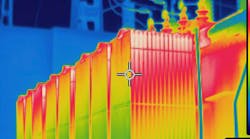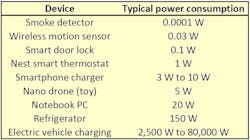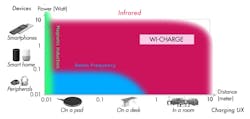Wi-Fi enables devices to wirelessly communicate. Without Wi-Fi, factories, businesses, and offices would be drastically less efficient, and homes would be much less convenient. With that said, all connected devices and the networks they make up have one thing in common: power consumption, and lots of it.
Whether by way of a wall outlet or battery that requires periodic charging or complete replacement, power delivery is arguably the largest factor holding back innovation and adoption of connected devices. Device manufacturers are constantly trying to find workarounds for power-hungry chips and computationally-intensive features, all while slimming down their devices to keep up with the competition and aiming to address the functionality and aesthetic demands of the consumer.
True Wireless Power is Possible
Internet connectivity, mobile payments, and audio transmission have all evolved in order to give consumers a more convenient, truly wireless experience. But what about power delivery?
Today, ‘Qi’ charging technology has become a standard for new mobile devices. While technically a type of wireless power transmission, it is not entirely wireless and only has a limited number of use cases. Qi charging pads require close proximity to and careful alignment between the charging pad and the mobile device being charged. This limits the technology’s ability to charge multiple devices at once or at a distance if needed, and it still requires a power cord to be plugged into an outlet to provide power to the Qi charger.
For internet-connected and other IoT devices to truly take off, they must have the ability to be charged wirelessly from a distance and across the room—without plugs and without contact. We’ll first examine the current ecosystem of wireless charging technologies, as well as their pros and cons, to help aid designers and manufacturers when developing their next line of products.
Factors for Selecting Devices for Wireless Charging
Different types of devices will require different amounts of power to operate or charge. Included below are typical power consumption values for several common devices.
Typical power consumption values for several common devices. (Courtesy: Wi-Charge)
Different device types have different power needs. It’s also critical to look at exactly how much power can be delivered wirelessly. There are some limiting factors that will affect energy delivery:
- Distance, which will be limited by diffraction
- Power, which will be limited by safety
To understand diffraction, think of a person trying to drink from a garden hose. Water is delivered from the hose into the person’s mouth. The water stream starts with a small diameter, and the farther away the person is from the hose, the wider the diameter of the water stream. At a distance, only a small percentage of that available water will be captured because the water stream widens and the water “receiver” (the person’s mouth) is small compared to the diameter of the stream. Water will be wasted or displaced onto the ground.
When a power beam becomes wider, the distance of the transmitter from the receiver impacts the power-capture ability. If only a small portion of transmitted energy is captured by the receiver, efficiency is reduced and much more energy needs to be sent from the transmitter to power the device. Additionally, energy that is not captured by the receiver bathes the environment, potentially creating unwanted effects for people, pets, and plants.
One option to improve efficiency would be to increase the receiver size, but creating a larger receiver makes the technology less practical for phones or other small and portable devices.
Another option to deliver the energy despite low efficiency is to increase the transmission power. However, depending on the type of energy, one might quickly reach the allowable safety limits as defined by the government.
Thus, to deliver wireless power we need a technology that can efficiently be captured by a small receiver at a distance, yet stays within the safety limits.
Device Candidates for Wireless Power
Devices that require large amounts of constant energy, such as refrigerators, will require an advanced level of wireless charging technology. Today’s devices that are typically battery-operated that trade power performance and capacity for mobility—such as smart home and mobile devices—are strong candidates for wireless charging applications that deserve the most attention and engineering efforts out of the gates.
There are three important things to consider when determining whether a device is optimal for receiving power wirelessly:
- Device power requirements: Long-range wireless power technology is currently geared toward powering devices that have an average wattage of 5 mW to about 5 W. For example, a smart lock, a smart speaker, and a smartphone would all fall under this category.
- Line-of-sight: Some technologies, such as infrared (IR) require line-of-sight technology. You need to have line-of-sight most of the time between the energy source and the device that’s being powered. This is an important consideration when deciding if a device is a good candidate for wireless power. Ask yourself: Can the IR transmitter and the intended charging device “see” each other?
- ROI: Is powering a device wirelessly the best solution? If you have a better solution, such as a battery or a power cord, you don’t need wireless power.
Innovation efforts should focus on applications where not being able to provide wire-free power is a significant limitation. Working closely with device manufacturers and governing bodies to innovate, test, and establish standards will be critical to creating an integrated and vast ecosystem of truly wireless technologies
Which Tech Can Safely Enable Cord-Cutting Power?
Battery anxiety for consumers will be a thing of the past in the very near future. And without power limitations, device manufacturers can finally make products that don’t sacrifice performance for portability. But which technology is best?
Radio frequency (RF) technology often comes up as a first choice from an engineering perspective. However, it has critical limitations: When RF is concentrated into a tight beam and sent to distances beyond 1M, it begins to disintegrate, and its power transfer is rendered useless. When RF’s power level is increased to compensate for this drop-off, there is a risk of violating the applicable safety standards for radio.
The biggest issue is at RF’s core. RF is a man-made radiation and can be very harmful to living organisms, which is why safety limits are reached at such an early point. Displacing the power requirements safely for smart home and mobile devices isn’t within the reach of RF technology.
Infrared Technology is the Answer
IR can transfer power efficiently at much longer distances. It can deliver more power than RF, all while staying within safety limits. Specifically, IR can power both mobile devices and smart devices anywhere in the room at distances of 10 and power levels of up to several Watts.
Infrared power can be easily packed into a tight beam and will carry its power over long distances. For example, if you examine a laser pointer, you’ll find that it can emit a focused beam of light over a long distance without disintegrating. IR is also much safer than RF or other power transfer technologies at a distance. IR is natural and is responsible for half of the solar energy heating the Earth. Living organisms, such as humans, animals, and even plants, are more adapted to it.
Although we may still be a few years away from powering larger appliances like laptops via wireless IR power, the combination of efficiency and safety show that IR can deliver more energy than RF technologies.
If you combine the physical phenomena of dispersion and the safety limits, you get the following performance envelope for the available technologies:
Device performance envelope (Courtesy: Wi-Charge)
The Future Ahead
The possibilities of wireless charging aren’t just limited to smart home and mobile devices. Wireless charging has critical applications on factory floors and in warehouses. Beacons and sensors can benefit from always-on, flexible wireless power. Wireless power enables all changing environments to scale as needed—essential in the Industrial Internet of Things (IIoT) market. With tethered power or battery anxiety no longer an issue, innovators are free to create with no obstacles in their way. It’s safe to say that wireless IR charging will usher in a new era of connected devices to the market.
Ori Mor is the vice president of research and development at Wi-Charge.



